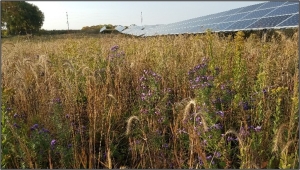What's Working for Conservation
Habitat Friendly Solar
2025 Information
BWSR’s Habitat Friendly Solar Started in 2016 through state legislation, the Habitat Friendly Solar Program encourages the

establishment of diverse native vegetation as part of solar projects. These projects offer landscape co-benefits such as carbon sequestration, water management, pollinator habitat, bird habitat, conservation grazing, and improved landscape aesthetics. There are approximately 70 projects that meet this state standard covering around 7000 acres and sequestering around 11,000 Metric Tons of carbon a year, and capturing around 16,000-acre feet of water. A key focus of this program is to build collaboration between the solar industry and conservation partners. A new resources is available on the program’s webpage to guide the yearly maintenance of solar projects.
Maintenance Recommendations:
The following information was developed as part of a collaboration between BWSR, MNL, and Natural Resource Services. More detailed sample maintenance sequences can be found at the following link: Pollinator Solar VM Sequences v2.pdf
MAINTENANCE PERIODS
- Establishment:
o Timeframe: Seeding through approximately third growing season
o Vegetation management should focus on mechanical cutting (mowing and trimming) 2-4 times
per growing season to control weed growth which allows seeded species to establish, especially
during the first two years
o Selective herbicide use should be introduced during the second growing season or as needed to
control perennial weeds and woody species
o Sheep grazing may be introduced during the second or third growing season if included in
management plan, as vegetation growth permits
- Long-term:
o Timeframe: Approximately fourth growing season onward
o Vegetation management can be reduced to the minimum required to prevent shading of
modules and vegetation interfering with solar equipment, and control noxious weeds
o Mowing should be reduced, ideally no more than 1-2 times per growing season depending on
panel height, equipment layout, and vegetation type. Hand trimming around equipment may be
conducted as needed.
o Selective herbicide use should continue, at least once per year or as needed to control perennial
weeds and woody species
o Sheep grazing may be implemented up to once each active growing season, with additional
grazing in dormant season optional for thatch and fire risk reduction. Grazing pollinator-solar
sites should be implemented only by experienced professionals at appropriate stocking densities
and timing, to avoid damage to the native plants
- Establishment:
o Timeframe: Seeding through approximately third growing season
o Vegetation management should focus on mechanical cutting (mowing and trimming) 2-4 times
per growing season to control weed growth which allows seeded species to establish, especially
during the first two years
o Selective herbicide use should be introduced during the second growing season or as needed to
control perennial weeds and woody species
o Sheep grazing may be introduced during the second or third growing season if included in
management plan, as vegetation growth permits
- Long-term:
o Timeframe: Approximately fourth growing season onward
o Vegetation management can be reduced to the minimum required to prevent shading of
modules and vegetation interfering with solar equipment, and control noxious weeds
o Mowing should be reduced, ideally no more than 1-2 times per growing season depending on
panel height, equipment layout, and vegetation type. Hand trimming around equipment may be
conducted as needed.
o Selective herbicide use should continue, at least once per year or as needed to control perennial
weeds and woody species
o Sheep grazing may be implemented up to once each active growing season, with additional
grazing in dormant season optional for thatch and fire risk reduction. Grazing pollinator-solar
sites should be implemented only by experienced professionals at appropriate stocking densities
and timing, to avoid damage to the native plants
Documentation of Habitat and Plant Diversity Benefits
During the summer of 2023 around 20 Habitat Friendly Solar projects were monitored in partnership with Lauren Agnew, a PhD student from the University of Minnesota. This was the first detailed study of solar projects conducted by BWSR to document their benefits.The following are key outcomes that have been documented for the program.
-Over 40 native insect species have been documented at the sites including bees from 5 of 6 Minnesota bee families, and six bumble bee species.
-No water was observed leaving the solar sites resulting in dry detention basins. This reinforces the ability of the deep rooted prairie vegetation to capture rainfall.
A monitoring form has been created for Habitat Friendly Solar projects to aid with documenting changes from year to year
